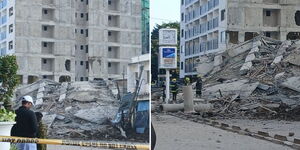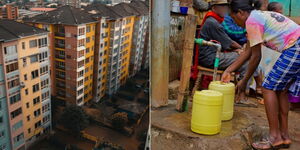A new wave of cost-efficient homes is taking root in Kenya, with the national government now calling on Kenyans looking to build homes to adapt to the expanded polystyrene (EPS) panels technology.
In one new development, around 50 polystyrene homes have been built in Kajiado County.
Public Works Principal Secretary Gordon Kihalangwa, during a forum held earlier in the week, said using such alternative technology is affordable, time-efficient and eco-friendly.
“Housing in this country is limited and the government is devoted to ensuring we have adequate technology to be used," he stated.
"We have companies manufacturing EPS, it is cleaner and takes less time to complete. For example, where a facility of brick and mortar takes one year, EPS can halve that with new technology,” he further explained
EPS building technology entails building homes by assembling ready-made EPS panels, sandwiched between a wire mesh that is sealed on both sides with concrete.
The panels are made from light cellular plastic foam, a by-product of oil refining, which consists of mini spherical particles containing about 98% air.
Because air is a poor conductor of heat, polystyrene houses can offer better insulation than homes made from timber or concrete.
A regular two-bedroom polystyrene house costs about Ksh735,670, while a similar stone structure can cost up to double the amount.
Costs savings average at around 25% while construction time is cut by half as the panels come ready for installation.
EPS is an inert material that does not rot and provides no nutritional benefits to vermin therefore does not attract pests such as rats or termites. Its strength, durability and lightweight nature makes it a versatile and popular building product.
Applications include insulated panel systems for walls, roofs and floors as well as facades for both domestic and commercial buildings.
The houses are sound and bulletproof, and they also have a high resistance to fire and other shocks.
In May of 2019, Kenya´s President Uhuru Kenyatta, in response to rising housing costs and increasing trends of rural-urban migration, declared that his administration would see to it that 500,000 homes would be built by the year 2022 as part of the Nation’s Affordable and Dignified Housing Plan (AHP).
Manufacturers of the system often have additional specialty components available for purchase. These included wall panels of varied thicknesses, floor panels, and stair systems.
Under the direction of a licensed engineer, EPS panels can be used to build up to 20 stories.
Other building technologies currently available are:
Compressed Agricultural Fiber (CAF) panels
These are insulated panels made of agriculture waste such as wheat and rice straw. The agri-waste is compressed at a high temperature and sealed with a final layer of cardboard.
Prefabricated offsite, the panels are lightweight and easily transported to a construction site. While the panels can be self-supporting, the system is best paired with a steel or wood frame structure as a primary structural system.
Interlocking Stabilized Soil Blocks (ISSBs)
These are a specific type of Compressed Stabilized Earth Block (CSEB) technology.
ISSBs are made from the same soil/cement ratio of 1:10. They present an interlocking form that allows for strong, rapidly assembled systems that do not need cement mortar.
Compression machines for brick fabrication can be powered by diesel fuel or electricity, or be operated with hand power.
ISSB fabrication is less expensive and requires less energy than conventional brick firing methods.
Watch a short clip of how EPS panel houses are built below:
{"preview_thumbnail":"/files/styles/video_embed_wysiwyg_preview/public/video_thumbnails/uPFg9zSe2FU.jpg?itok=eRst7iDC","video_url":"","settings":{"responsive":1,"width":"854","height":"480","autoplay":0},"settings_summary":["Embedded Video (Responsive)."]}












